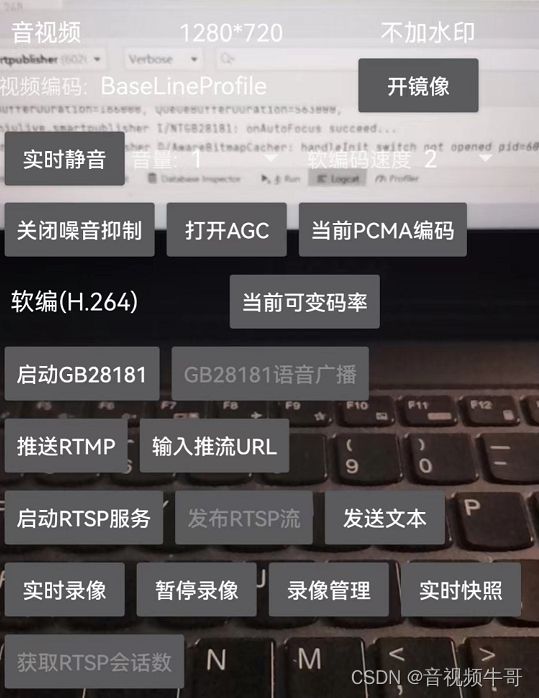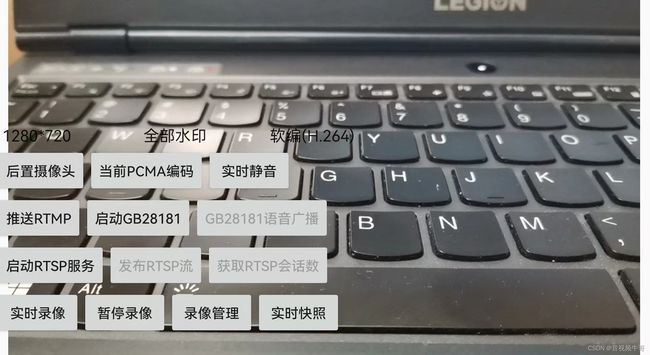Android平台GB28181设备接入模块摄像头采集方向不对怎么办?
背景
我们在做Android平台GB28181设备接入模块的时候,有开发者提到这样的诉求:他们的智能头盔、执法记录仪等设备,采集到的图像,是旋转了90、180甚至270°的,设备本身无法针对图像做翻转或者旋转操作,问我们这种情况下需要如何处理?
实际上,这块,我们前几年在做RTMP推送和轻量级RTSP服务模块的时候,老早处理了这类问题。
鉴于Android平台video数据采集分camera和camera2(Android 5.0+)接口,我们单独说明:
camera接口示例
//Github: https://github.com/daniulive/SmarterStreaming
//author: [email protected]
@Override
public void onPreviewFrame(byte[] data, Camera camera) {
frameCount++;
if (frameCount % 3000 == 0) {
Log.i("OnPre", "gc+");
System.gc();
Log.i("OnPre", "gc-");
}
if (data == null) {
Parameters params = camera.getParameters();
Size size = params.getPreviewSize();
int bufferSize = (((size.width | 0x1f) + 1) * size.height * ImageFormat.getBitsPerPixel(params.getPreviewFormat())) / 8;
camera.addCallbackBuffer(new byte[bufferSize]);
} else {
if (isRTSPPublisherRunning || isPushingRtmp || isRecording || isGB28181StreamRunning) {
if (1 == video_opt_) {
/* byte[] i420_data = new byte[videoWidth*videoHeight*3/2];
libPublisher.SmartPublisherNV21ToI420Rotate(publisherHandle, data, videoWidth, videoWidth,i420_data, videoHeight, videoHeight/2, videoHeight/2,
videoWidth, videoHeight, 90);
libPublisher.SmartPublisherOnCaptureVideoI420DataV2(publisherHandle, i420_data, videoHeight, videoWidth,videoHeight, videoHeight/2, videoHeight/2);
*/
libPublisher.SmartPublisherOnCaptureVideoData(publisherHandle, data, data.length, currentCameraType, currentOrigentation);
} else if (3 == video_opt_) {
int w = videoWidth, h = videoHeight;
int y_stride = videoWidth, uv_stride = videoWidth;
int y_offset = 0, uv_offset = videoWidth * videoHeight;
int is_vertical_flip = 0, is_horizontal_flip = 0;
int rotation_degree = 0;
// 镜像只用在前置摄像头场景下
if (is_mirror && FRONT == currentCameraType) {
// 竖屏, (垂直翻转->顺时旋转270度)等价于(顺时旋转旋转270度->水平翻转)
if (PORTRAIT == currentOrigentation)
is_vertical_flip = 1;
else
is_horizontal_flip = 1;
}
if (PORTRAIT == currentOrigentation) {
if (BACK == currentCameraType)
rotation_degree = 90;
else
rotation_degree = 270;
} else if (LANDSCAPE_LEFT_HOME_KEY == currentOrigentation) {
rotation_degree = 180;
}
if (640 == w && 480 == h && PORTRAIT == currentOrigentation) {
// 480 * 640 竖屏情况下裁剪到 368 * 640, 均匀裁剪掉视频的上下两部分
h = 368;
y_offset = 56 * y_stride;
uv_offset += (56 >> 1) * uv_stride;
}
int scale_w = 0, scale_h = 0, scale_filter_mode = 0;
// 缩放测试++
/*
if (w >= 1280 && h >= 720) {
scale_w = align((int)(w * 0.8 + 0.5), 2);
scale_h = align((int)(h * 0.8 + 0.5), 2);
} else {
scale_w = align((int)(w * 1.5 + 0.5), 2);
scale_h = align((int)(h * 1.5 + 0.5), 2);
}
if(scale_w >0 && scale_h >0) {
scale_filter_mode = 3;
Log.i(TAG, "onPreviewFrame w:" + w + ", h:" + h + " s_w:" + scale_w + ", s_h:" + scale_h);
}
*/
// 缩放测试---
libPublisher.PostLayerImageNV21ByteArray(publisherHandle, 0, 0, 0,
data, y_offset, y_stride, data, uv_offset, uv_stride, w, h,
is_vertical_flip, is_horizontal_flip, scale_w, scale_h, scale_filter_mode, rotation_degree);
// i420接口测试++
/*
byte[] i420_data = new byte[videoWidth*videoHeight*3/2];
int u_stride = videoWidth >> 1;
int v_stride = u_stride;
libPublisher.SmartPublisherNV21ToI420Rotate(publisherHandle, data, y_stride, uv_stride, i420_data, y_stride, u_stride, v_stride,
videoWidth, videoHeight, 0);
y_offset = 0;
int u_offset = y_offset + videoWidth * videoHeight;
int v_offset = u_offset + videoWidth*videoHeight/4;
libPublisher.PostLayerImageI420ByteArray(publisherHandle, 0, 0, 0,
i420_data, y_offset, y_stride, i420_data, u_offset, u_stride, i420_data, v_offset, v_stride,
w, h, is_vertical_flip, is_horizontal_flip, scale_w, scale_h, scale_filter_mode, rotation_degree);
*/
// i420接口测试--
}
}
camera.addCallbackBuffer(data);
}
}对应的接口设计如下:
/**
* 投递层NV21图像
*
* @param index: 层索引, 必须大于等于0
*
* @param left: 层叠加的左上角坐标, 对于第0层的话传0
*
* @param top: 层叠加的左上角坐标, 对于第0层的话传0
*
* @param y_plane: y平面图像数据
*
* @param y_offset: 图像偏移, 这个主要目的是用来做clip的,一般传0
*
* @param y_row_stride: stride information
*
* @param uv_plane: uv平面图像数据
*
* @param uv_offset: 图像偏移, 这个主要目的是用来做clip的,一般传0
*
* @param uv_row_stride: stride information
*
* @param width: width, 必须大于1, 且必须是偶数
*
* @param height: height, 必须大于1, 且必须是偶数
*
* @param is_vertical_flip: 是否垂直翻转, 0不翻转, 1翻转
*
* @param is_horizontal_flip:是否水平翻转, 0不翻转, 1翻转
*
* @param scale_width: 缩放宽,必须是偶数, 0或负数不缩放
*
* @param scale_height: 缩放高, 必须是偶数, 0或负数不缩放
*
* @param scale_filter_mode: 缩放质量, 传0使用默认速度,可选等级范围是:[1,3],值越大缩放质量越好, 但速度越慢
*
* @param rotation_degree: 顺时针旋转, 必须是0, 90, 180, 270, 注意:旋转是在缩放, 垂直/水品反转之后再做, 请留意顺序
*
* @return {0} if successful
*/
public native int PostLayerImageNV21ByteArray(long handle, int index, int left, int top,
byte[] y_plane, int y_offset, int y_row_stride,
byte[] uv_plane, int uv_offset, int uv_row_stride,
int width, int height, int is_vertical_flip, int is_horizontal_flip,
int scale_width, int scale_height, int scale_filter_mode,
int rotation_degree);对应Camera2的接口示例
@Override
public void onCameraImageData(Image image) {
Rect crop_rect = image.getCropRect();
if (isPushingRtmp || isRTSPPublisherRunning || isGB28181StreamRunning || isRecording) {
if (libPublisher != null) {
Image.Plane[] planes = image.getPlanes();
int w = image.getWidth(), h = image.getHeight();
int y_offset = 0, u_offset = 0, v_offset = 0;
if (!crop_rect.isEmpty()) {
// 裁剪测试++, 视频中心裁剪320*180一块区域
/*crop_rect.left = image.getWidth()/2 - 320/2;
crop_rect.top = image.getHeight()/2 - 180/2;
crop_rect.right = crop_rect.left + 320;
crop_rect.bottom = crop_rect.top + 180;
*/
// 裁剪测试--
w = crop_rect.width();
h = crop_rect.height();
y_offset += crop_rect.top * planes[0].getRowStride() + crop_rect.left * planes[0].getPixelStride();
u_offset += (crop_rect.top / 2) * planes[1].getRowStride() + (crop_rect.left / 2) * planes[1].getPixelStride();
v_offset += (crop_rect.top / 2) * planes[2].getRowStride() + (crop_rect.left / 2) * planes[2].getPixelStride();
;
// Log.i(TAG, "crop w:" + w + " h:" + h + " y_offset:"+ y_offset + " u_offset:" + u_offset + " v_offset:" + v_offset);
}
int scale_w = 0, scale_h = 0, scale_filter_mode = 0;
scale_filter_mode = 3;
int rotation_degree = cameraImageRotationDegree_;
if (rotation_degree < 0) {
Log.i(TAG, "onCameraImageData rotation_degree < 0, may need to set orientation_ to 0, 90, 180 or 270");
return;
}
libPublisher.PostLayerImageYUV420888ByteBuffer(publisherHandle, 0, 0, 0,
planes[0].getBuffer(), y_offset, planes[0].getRowStride(),
planes[1].getBuffer(), u_offset, planes[1].getRowStride(),
planes[2].getBuffer(), v_offset, planes[2].getRowStride(), planes[1].getPixelStride(),
w, h, 0, 0,
scale_w, scale_h, scale_filter_mode, rotation_degree);
}
}
}对应的接口设计如下:
/**
* 投递层YUV420888图像, 专门为android.media.Image的android.graphics.ImageFormat.YUV_420_888格式提供的接口
*
* @param index: 层索引, 必须大于等于0
*
* @param left: 层叠加的左上角坐标, 对于第0层的话传0
*
* @param top: 层叠加的左上角坐标, 对于第0层的话传0
*
* @param y_plane: 对应android.media.Image.Plane[0].getBuffer()
*
* @param y_offset: 图像偏移, 这个主要目的是用来做clip的,一般传0
*
* @param y_row_stride: 对应android.media.Image.Plane[0].getRowStride()
*
* @param u_plane: android.media.Image.Plane[1].getBuffer()
*
* @param u_offset: 图像偏移, 这个主要目的是用来做clip的,一般传0
*
* @param u_row_stride: android.media.Image.Plane[1].getRowStride()
*
* @param v_plane: 对应android.media.Image.Plane[2].getBuffer()
*
* @param v_offset: 图像偏移, 这个主要目的是用来做clip的,一般传0
*
* @param v_row_stride: 对应android.media.Image.Plane[2].getRowStride()
*
* @param uv_pixel_stride: 对应android.media.Image.Plane[1].getPixelStride()
*
* @param width: width, 必须大于1, 且必须是偶数
*
* @param height: height, 必须大于1, 且必须是偶数
*
* @param is_vertical_flip: 是否垂直翻转, 0不翻转, 1翻转
*
* @param is_horizontal_flip:是否水平翻转, 0不翻转, 1翻转
*
* @param scale_width: 缩放宽,必须是偶数, 0或负数不缩放
*
* @param scale_height: 缩放高, 必须是偶数, 0或负数不缩放
*
* @param scale_filter_mode: 缩放质量, 传0使用默认速度,可选等级范围是:[1,3],值越大缩放质量越好, 但速度越慢
*
* @param rotation_degree: 顺时针旋转, 必须是0, 90, 180, 270, 注意:旋转是在缩放, 垂直/水品反转之后再做, 请留意顺序
*
* @return {0} if successful
*/
public native int PostLayerImageYUV420888ByteBuffer(long handle, int index, int left, int top,
ByteBuffer y_plane, int y_offset, int y_row_stride,
ByteBuffer u_plane, int u_offset, int u_row_stride,
ByteBuffer v_plane, int v_offset, int v_row_stride, int uv_pixel_stride,
int width, int height, int is_vertical_flip, int is_horizontal_flip,
int scale_width, int scale_height, int scale_filter_mode,
int rotation_degree);总结
无需赘述,看过以上两个接口后,是不是觉得,即使数据需要更客制化的处理,比如缩放、水平翻转、垂直翻转、旋转等,也都可以实现?
实际上,数据源这块,不止Android自带的采集设备,其他编码前数据类型(如YV12/NV21/NV12/I420/RGB24/RGBA32/RGB565),均可实现更精细的处理。

